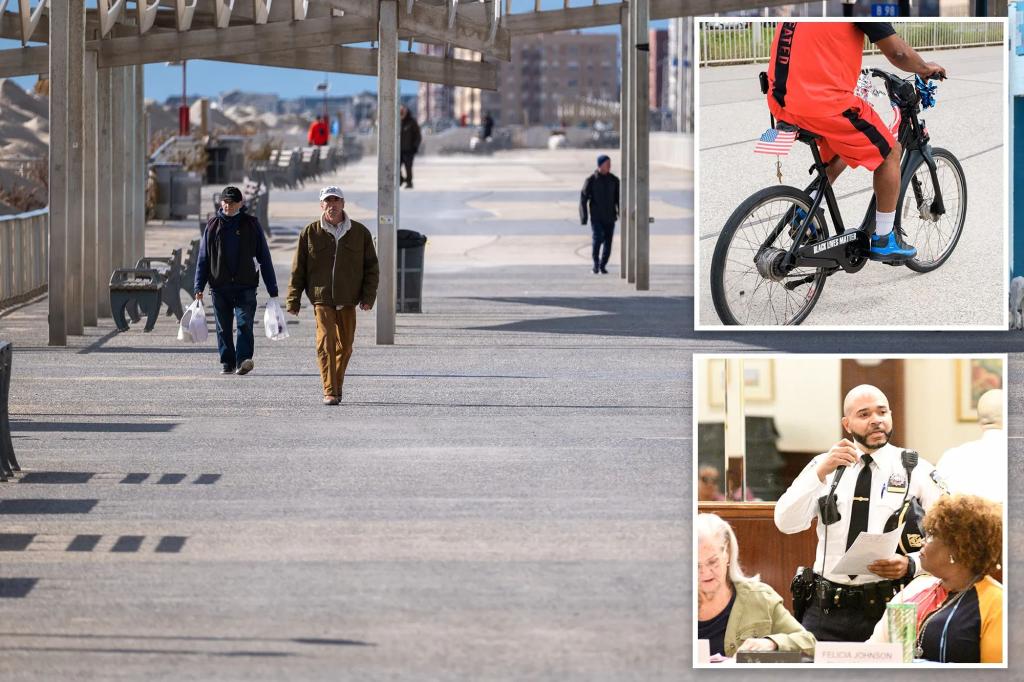The city has pumped the brakes on a divisive new proposal.
A controversial bicycle ban on a popular strip of Rockaway Beach’s famous boardwalk has been scrapped – less than a month after it was floated – following mass community blowback and protests, The Post has learned.
The proposal, which sought to bar speeding cyclists from riding the boardwalk between Beach 108th Street and Beach 73rd Street from Memorial Day weekend through October, was sparked by a string of recent accidents — but it was ultimately no match for outraged locals.
NYC Parks rep Elizabeth Walsack rep told a community board meeting Tuesday night that the now-axed proposal was “bad timing” and said there was a misconception that the motion was an immediate ban.
“I’m glad that the Parks Department is going to continue allowing Rockaway residents to enjoy their bikes on the boardwalk this summer, but now we need real enforcement,” Queens council member Joann Ariola told The Post.
“NYPD and [Parks Enforcement Patrol] officers must step up patrols to ensure riders dismount in concession areas, and they need to crack down on the Tour de France-style cyclists treating the boardwalk like a racetrack,” she added. “This space is meant for leisure, not speed trials, and we cannot put the safety of beachgoers at risk.”
In an interview last week, the council member noted Parks had received “so many” recent complaints from locals reporting 20-25 cyclists riding at breakneck speed and training for races – but acknowledged that local families should not be penalized for misuse of the beachside respite.
In lieu of the bicycle block, Parks will kick off the beach season by beefing up signage and dismounting enforcement at the boardwalk’s three concession areas at Beach 86th, 97th, and 106th Streets and “step up” in Parks Enforcement Patrol along the boardwalk “in an effort to educate and increase compliance.”
Speaking at the Tuesday night meeting, Queens parent Andreanna Seymore called the proposed bike ban “asinine,” likening it to banning swimming at city beaches after a drowning. Instead, she argued Parks should focus on educating both cyclists and pedestrians on boardwalk “etiquette.”
Other residents pointed out that a growing number of non-English speakers in the area may not be able to read signs, and instead urged Parks to install color-coded bike lanes.
Queens Community Board 14 member Jose Santana told The Post he was stunned that the boardwalk bike lanes aren’t painted — only marked with faint stencils. Painting them green, as is customary throughout the city — would be a cost-effective way to ensure universal understanding for both pedestrians and cyclists, he said.
“I am asking for them to do a study on what can be done for it to be safe,” Santana added, “because while everybody can give opinions, nobody’s going to know exactly what’s the best way to move forward until a study is done.”
The community board, which also voted on Rockaway Beach Amphitheater noise regulations, voted 30-1 Tuesday night to install the new Parks signage — but emphasized even more needs to be done to ensure safety at the waterfront.
Board chairperson Dolores Orr also called for the entire boardwalk bike lane to be clearly marked and for long-requested safety measures to be implemented: bike lane signs on every other light pole in both directions, an 8 mph speed limit and signage alerting pedestrians and cyclists to crossings and right-of-way rules.
Cyclist and pedestrian safety improvements alike have been largely missing from the boardwalk, even after the boardwalk was rebuilt after 2012’s Hurricane Sandy.
“When we first saw the design when the boardwalk was being built, we said you can’t distinguish the bike lane from the rest of the boardwalk, and we were ignored,” Orr said.
“And then when the boardwalk was built and opened, we had the same repeat of that concern, and it’s been every year since,” she added. “We’re [also] asking for the following signage, and most of it was, again, asked from the day the boardwalk opened.”
Read the full article here


